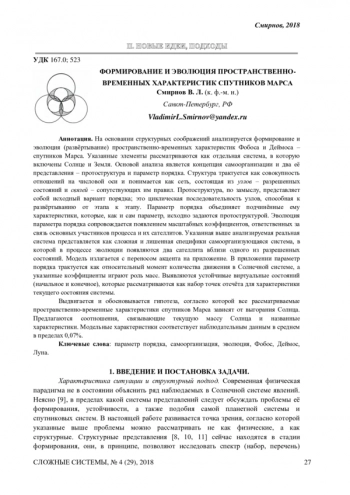На основании структурных соображений анализируется формирование и эволюция (развёртывание) пространственно-временных характеристик Фобоса и Деймоса – спутников Марса. Указанные элементы рассматриваются как отдельная система, в которую включены Солнце и Земля. Основой анализа является концепция самоорганизации и два её представления – протоструктура и параметр порядка. Структура трактуется как совокупность отношений на числовой оси и понимается как сеть, состоящая из узлов – разрешенных состояний и связей – сопутствующих им правил. Протоструктура, по замыслу, представляет собой исходный вариант порядка; это циклическая последовательность узлов, способная к развёртыванию от этапа к этапу. Параметр порядка объединяет подчинённые ему характеристики, которые, как и сам параметр, исходно задаются протоструктурой. Эволюция параметра порядка сопровождается появлением масштабных коэффициентов, ответственных за связь основных участников процесса и их сателлитов. Указанная выше анализируемая реальная система представляется как сложная и лишенная специфики самоорганизующаяся система, в которой в процессе эволюции появляются два сателлита вблизи одного из разрешенных состояний. Модель излагается с переносом акцента на приложение. В приложении параметр порядка трактуется как относительный момент количества движения в Солнечной системе, а указанные коэффициенты играют роль масс. Выявляются устойчивые виртуальные состояний (начальное и конечное), которые рассматриваются как набор точек отсчёта для характеристики текущего состояния системы.
Выдвигается и обосновывается гипотеза, согласно которой все рассматриваемые пространственно-временные характеристики спутников Марса зависят от выгорания Солнца. Предлагаются соотношения, связывающие текущую массу Солнца и названные характеристики. Модельные характеристики соответствует наблюдательным данным в среднем в пределах 0,07%.
Based on the structural considerations, the formation and evolution of the
spatiotemporal characteristics of Phobos and Deimos – the moons of Mars – are analyzed. These
elements are considered as a separate system, which includes the Sun and the Earth. The analysis is based on the concept of self-organization and its two representations – the proto-structure and the order parameter. The structure is interpreted as a set of relations on the numerical axis and is understood as a network of nodes (the allowed states and connections) of the rules accompanying them. The proto-structure is intended to be the original variant order; it is a cyclic sequence of nodes capable of deploying from stage to stage. The order parameter combines the characteristics subordinate to it, which, like the parameter itself, are initially set by the proto-structure. The evolution of the order parameter is accompanied by the appearance of scale factors responsible connecting the main elements of the process and their satellites. The above-analyzed real-world system is represented as a complex self-organizing system having no specifics, where the process of evolution two satellites appear near one of the allowed states. In the presentation of the model the focus is shifted on the application. In the application, the order parameter is interpreted as the relative angular momentum in the Solar System, while the indicated coefficients act as masses. The identified stable virtual states (initial and final) are considered as a set of reference points to characterize the current state of the system.
The paper puts forward and substantiates a hypothesis that all the considered spatiotemporal characteristics of the moons of Mars depend on the Sun’s burnout. The relations connecting the current mass of the Sun and the named characteristics are proposed. Model characteristics correspond to observational data on average within 0.07%.




